
A. There is an intraperitoneal bladder rupture.
B. There is an extraperitoneal bladder rupture.
C. There is no bladder injury.
D. The bladder is nondiagnostic.
2 A 40-year-old nursing home resident with neurocognitive deficits and urinary retention is found to have bladder cancer attributable to a chronic indwelling Foley catheter. Which of the following risk factors for bladder cancer is classically associated with the same malignant cell type?
A. Smoking history
B. Urachal remnant
C. Schistosoma haematobium infection
D. Polycyclic aromatic hydrocarbon exposure
3 A 60-year-old male with a 50-pack-year smoking history presents with pelvic pain and gross hematuria. A CT is performed demonstrating a left anterolateral bladder mass that is later confirmed to be urothelial carcinoma. Based on the TNM classification system and below imaging findings, what is the T stage of this tumor?
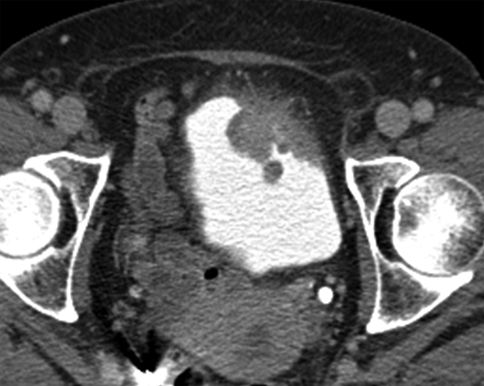
A. T1
B. T2
C. T3
D. T4
E. The T stage cannot be reliably determined.
4 A 30-year-old female with postvoid dribbling undergoes pelvic MR to localize a suspected urethral diverticulum. She has questions about the safety of MRI. What is the maximum allowed whole-body specific absorption rate for an otherwise healthy patient based on FDA guidelines?
A. 2 W/kg every 15 minutes
B. 4 W/kg every 15 minutes
C. 8 W/kg every 15 minutes
D. 16 W/kg every 15 minutes
5 A 25-year-old female with recurrent urinary tract infections undergoes a fluoroscopic voiding cystourethrogram (VCUG). If the analog spatial resolution of this study is 4 lp/mm, what is the pixel spacing required to preserve this resolution in a digital format?
A. 0.125 mm
B. 0.250 mm
C. 0.375 mm
D. 0.500 mm
6 Where along the male urethra are the glands of Littre?
A. Dorsal surface of the anterior urethra
B. Ventral surface of the anterior urethra
C. Dorsal surface of the posterior urethra
D. Ventral surface of the posterior urethra
7 A 42-year-old male with type 1 diabetes mellitus presents with abdominal pain and systemic inflammatory response syndrome (SIRS). A urine specimen is obtained with a Foley catheter, and a CT of the abdomen and pelvis is performed (below). What is the most appropriate management?

A. Ignore (incidental finding)
B. Suprapubic catheter
C. Antibiotics
D. Urgent cystectomy
8 A 72-year-old male inpatient with congestive heart failure, atrial fibrillation, and sepsis presents with hematuria. A CT urogram is performed demonstrating a mass in the urinary bladder, and an image representative of the entire abnormality is shown below. Which of the following risk factors would best explain the imaging findings?

A. A 40-pack-year smoking history
B. Warfarin therapy
C. Hyperparathyroidism
D. Diabetes mellitus type 1
9 A 55-year-old male with benign prostatic hyperplasia presents with palpitations and fainting spells during micturition. A CT is performed demonstrating an enlarged prostate gland and a small 1-cm mass along the left lateral bladder wall. Which of the following bladder tumors is classically associated with this history?

A. Metastatic melanoma
B. Urothelial cancer
C. Paraganglioma
D. Squamous cell carcinoma
E. Adenocarcinoma
10 A 25-year-old male suffers severe pelvic trauma and develops a type II urethral injury. Which of the following mechanisms is most strongly associated with this injury pattern?
A. Blunt anterior injury
B. Shearing injury
C. Anterior penetrating injury
D. Straddle injury
11 A 55-year-old male with squamous cell carcinoma of the urethra presents for an MR of the penis to determine local disease extent. Which of the following TE and flip angle combinations will produce the most T1 weighting on a gradient echo pulse sequence using a TR of 50 msec?
A. TE: 40 msec; flip angle: 70 degrees
B. TE: 40 msec; flip angle: 20 degrees
C. TE: 10 msec; flip angle: 70 degrees
D. TE: 10 msec; flip angle: 20 degrees
12 A 28-year-old radiology resident in her 22nd week of pregnancy is scheduled to perform fluoroscopic voiding cystourethrograms (VCUG) while on the genitourinary radiology service. What is the regulatory radiation dose limit for her fetus once she declares her pregnancy?
A. 0.05 mSv
B. 0.5 mSv
C. 5 mSv
D. 50 mSv
13 A 14-year-old male is involved in an equestrian accident and presents with blood at the urethral meatus. He undergoes a retrograde urethrogram. How would you classify this urethral injury?

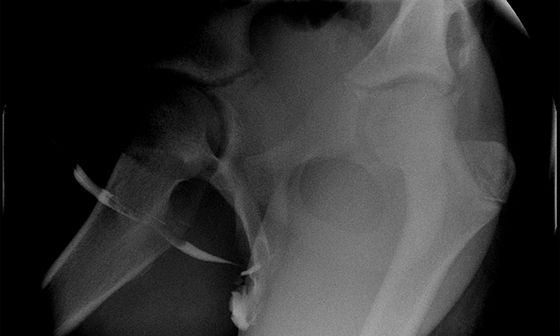
A. Type I
B. Type II
C. Type III
D. Type IV/IVa
E. Type V
14 A 32-year-old male with no relevant past medical history was involved in a motor vehicle collision and sustained pelvic trauma. A retrograde urethrogram was performed and is shown below. What best characterizes the findings in the posterior urethra?

A. Normal
B. Stricture of the bulbar urethra
C. Stricture of the bulbar and membranous urethra
D. Stricture of the bulbar, membranous, and prostatic urethra
15 A 20-year-old male trauma victim presents with blood at the urethral meatus. What is the best next step to evaluate this patient’s suspected injury?
A. Retrograde urethrogram
B. Foley catheter placement
C. CT cystogram
D. CT urogram
16 An 85-year-old male with asymptomatic microhematuria undergoes a CT urogram and is noted to have an unusually shaped bladder. What is the etiology of this finding?


A. Obliterated median umbilical ligament
B. Obliterated medial umbilical ligament
C. Incomplete closure of the median umbilical ligament
D. Incomplete closure of the medial umbilical ligament
17 A 50-year-old female with recurrent urinary tract infections undergoes a CT urogram. Which of the following risk factors best explains her recurrent infections?


A. Urinary stasis
B. Bladder calculi
C. Vesicoureteric reflux
D. Colovesical fistula
E. Vesicovaginal fistula
18 A 57-year-old female with leukemia undergoes an unenhanced CT for gross hematuria. Which of the following chemotherapeutics is the most likely cause of the imaging findings?
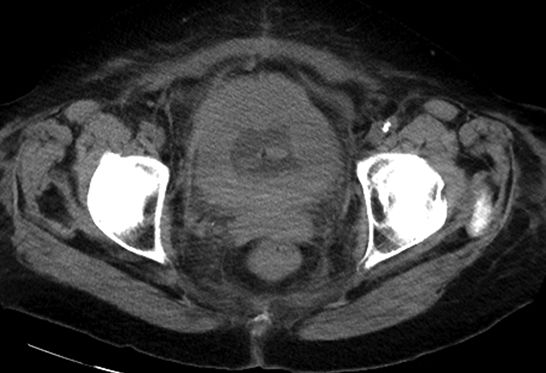
A. Etoposide
B. Methotrexate
C. Cyclophosphamide
D. Cytarabine
E. Vincristine
19 A 65-year-old male has multiple urinary tract infections 5 years after prostatectomy and salvage radiotherapy for T3a prostate cancer. A cystogram is performed. What is the most likely cause of his symptoms?

A. Urinary stasis
B. Vesicoureteric reflux
C. Colovesical fistula
D. Enterovesical fistula
20 A 52-year-old female with a 40-pack-year smoking history presents with urinary incontinence. An intravenous urogram is performed. What is the most likely diagnosis?

A. Neurogenic bladder
B. Patent urachus
C. Urachal adenocarcinoma
D. Vesicovaginal fistula
E. Vesicoureteric reflux
21 What visible anatomic landmark most reliably signifies the junction between the anterior and posterior urethra on retrograde urethrography?
A. Inferior margins of the obturator foramina
B. Superior margins of the obturator foramina
C. Cone-shaped end of the bulbar urethra
D. Cone-shaped end of the membranous urethra
22 A 69-year-old male undergoes radical prostatectomy for Gleason sum 7 prostate cancer. A cystogram is performed 2 weeks later. What best describes the imaging findings?


A. Normal study
B. Coloenteric fistula
C. Colovesical fistula
D. Anastomotic leak
23 A 60-year-old male with bladder cancer and a hip replacement undergoes contrast-enhanced MR of the pelvis with both extracellular gadolinium-based contrast material and ultrasmall iron oxide particles (USPIO). Match the materials with the corresponding class of susceptibility.

24 What is a “watering can perineum”?
A. Postinfectious perineal fistulas
B. Gangrenous perineal abscesses
C. Severe perineal edema
D. Postoperative perineal ulcers
25 A 50-year-old male with history of Chlamydia trachomatis infection and difficulty with urination undergoes a retrograde urethrogram. What best describes the imaging findings?
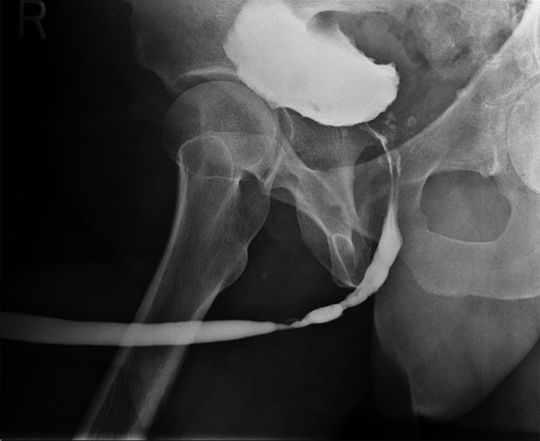
A. Normal study
B. Strictures of the anterior urethra
C. Strictures of the posterior urethra
D. Strictures of both the anterior and posterior urethra
26 A 29-year-old female with right flank pain and a dilated right collecting system undergoes a CT urogram. What is likely the underlying cause of this patient’s collecting system dilation?

A. Renal calculus
B. Congenital duplication
C. Vesicoureteric reflux
D. Prune belly syndrome
27 A 33-year-old female with pelvic discomfort and a soft palpable mass along the anterior vaginal wall undergoes pelvic MR. Representative T2-weighted images with and without fat saturation are shown below. What is the most likely diagnosis?
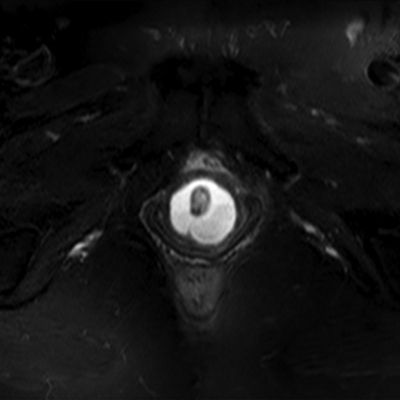

A. Normal study
B. Gartner duct cyst
C. Bartholin gland cyst
D. Urethral diverticulum
28 Where is the verumontanum?
A. Seminal vesicles
B. Bladder
C. Prostatic urethra
D. Membranous urethra
29 A 70-year-old male undergoes a postoperative cystogram. What is the best explanation for the appearance of the bladder?

A. Psoas hitch
B. Contained bladder rupture
C. Malpositioned ureteral stent
D. Congenital megaureter
30 A 66-year-old male with fevers undergoes a retroperitoneal ultrasound demonstrating gas in the bladder wall. What is the cause of the so-called “dirty shadowing” posterior to the gas?


A. Reverberation artifact
B. Mirror-image artifact
C. Twinkling artifact
D. Comet tail artifact
E. Side lobe artifact
Answers and Explanations
1 Answer D. Venous-phase CT is typically unable to diagnose bladder injury because the kidneys have not yet excreted contrast material. In some cases, delayed-phase (i.e., excretory phase) CT can demonstrate a bladder leak if there is extraluminal contrast material. However, delayed-phase CT is not sensitive for this abnormality. Therefore, venous- and delayed-phase CT imaging of the bladder are insufficient to exclude a bladder injury. Cystography is required (either fluoroscopic or CT cystography). This is because the bladder must be distended with sufficient pressure to “stress” the wall and reveal small defects. The typical volume that must be instilled in an adult patient is 300 to 400 mL, although that varies based on several factors, including patient age, patient size, prior operations, prior pelvic radiation, and the size of the defect (if any). The amount instilled is often driven by patient symptoms.
Examples of intraperitoneal (on left) and extraperitoneal (on right) bladder injury are shown below. Discriminating between the two major types of bladder injury is important because the management differs. Intraperitoneal bladder injuries are managed operatively, and extraperitoneal bladder injuries are managed with Foley catheter decompression.

Intraperitoneal bladder rupture

Extraperitoneal bladder rupture

Intraperitoneal bladder rupture

Extraperitoneal bladder rupture
References: Mee SL, McAnnich JW, Federle MP. Computerized tomography in bladder rupture: diagnostic limitations. J Urol 1987;137:207–209.
Pao DM, Ellis JH, Cohan RH, et al. Utility of routine trauma CT in the detection of bladder rupture. Acad Radiol 2000;7:317–324.
Vaccaro JP, Brody JM. CT cystography in the evaluation of major bladder trauma. Radiographics 2000;20:1373–1381.
2 Answer C. Patients with chronic indwelling Foley catheters are at risk for squamous cell carcinoma of the bladder. This cell type represents the minority of bladder cancers in the United States (<5%) but is more common worldwide due to Schistosoma haematobium infection in endemic areas. Squamous cell carcinoma of the bladder occurs in the setting of chronic bladder wall inflammation; both chronic Foley catheter use and Schistosoma haematobium infection result in this. Smoking (Answer A) and exposure to industrial chemicals (Answer D) are dominant risk factors for urothelial carcinoma, which is the most common type of bladder cancer in the United States. “Urothelial carcinoma” is the new name applied to “transitional cell carcinoma,” because although it is usually composed predominantly of transitional cell neoplasia, it often has a blend of cell types. Congenital urachal remnant abnormalities (Answer B) are associated with adenocarcinoma of the bladder.
References: Kaufman DS, Shipley WU, Feldman AS. Bladder cancer. Lancet 2009;374:239–249.
Shokeir AA. Squamous cell carcinoma of the bladder: pathology, diagnosis, and treatment. BJU Int 2004;93:216–220.
Stay updated, free articles. Join our Telegram channel

Full access? Get Clinical Tree






